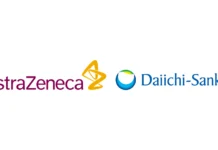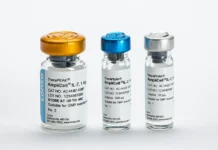Recently announced results from two-year CATT (Comparison of Age-related macular degeneration Treatment Trials) adds to the growing body of evidence, including CATT 1-year data and two retrospective database analyses, suggesting serious safety concerns associated with the use of unlicensed intravitreal Avastin®.
The full two year data from this study of 1107 patients with wet AMD shows a 30% higher risk in overall serious systemic adverse events with unlicensed intravitreal bevacizumab versus Lucentis (p=0.004). This is a similar finding to the year one data[2]. Furthermore, the study highlights reports of arteriothrombotic events, systemic hemorrhage, congestive heart failure, venous thrombotic events, hypertension and vascular death that were more frequent in bevacizumab treated patients (p=0.07). These events have been previously associated with systemic anti-VEGF treatment.
In addition, as in year one, there were significantly more gastrointestinal disorders in patients treated with unlicensed intravitreal bevacizumab compared to Lucentis (p=0.005). As the CATT authors comment, this has been an area of concern in previous studies of systemic bevacizumab[1].
“This data adds to the growing body of evidence suggesting that the overall risk of serious ocular and systemic side effects is higher with unlicensed intravitreal bevacizumab compared to Lucentis. However, the studies were not powered to assess differences in infrequent but serious events such as death and stroke, which were found in previously published large Medicare database analyses to be significantly more frequent with unlicensed Avastin,” said Tim Wright, Global Head of Development, Novartis Pharma. “The apparent differential safety risk between the two medicines may be due to differences in the molecules and their commercial formulation. This underscores the importance of drug design and development with the patient and disease process in mind.”
Previously published retrospective Medicare analyses compared the safety of unlicensed ocular bevacizumab and Lucentis for treating wet AMD[3],[4]. The primary analysis from the Curtis study showed that unlicensed bevacizumab and Lucentis were not associated with increased risks of death, heart attack, bleeding or stroke compared with photodynamic therapy or pegaptanib. A secondary analysis in the Curtis et al study, which included approximately 40,000 patients, showed a significantly higher risk of mortality (16%) and stroke (28%) with unlicensed intravitreal bevacizumab than with Lucentis. Gower et al. assessed 77,886 Medicare beneficiaries with wet AMD over 10 months. In this study patients treated with unlicensed intravitreal bevacizumab experienced an 11% significantly increased risk of death and a 57% significantly increased risk of hemorrhagic stroke compared to patients treated with Lucentis. The risk of ocular inflammation was 80% higher with unlicensed intravitreal bevacizumab than with Lucentis.
In addition to the serious systemic safety concerns, in the past year since the first year CATT results were presented, there have been reports of additional clusters of severe eye inflammation, some resulting in blindness, following unlicensed intravitreal bevacizumab use across the United States and in the United Kingdom.
These important findings and continued reported clusters of eye inflammation have been recognized by several health authorities and other organizations around the world, including Sweden’s Medical Products Agency and Health Canada, resulting in increased safety warnings on the use of unlicensed intravitreal bevacizumab.
Irrespective of the results of CATT or any other head-to-head study, bevacizumab remains unlicensed for any ocular condition, for administration in the eye and compounding into smaller doses.
Novartis puts patient safety first and believes Lucentis is the best treatment option for patients with wet AMD. Novartis believes that, within regulatory guidelines, the unlicensed use of drugs should be limited to cases where there is an unmet medical need which cannot be fulfilled by licensed medications.
More information on CATT two-year results
At two years, patients receiving as needed Lucentis fully maintained first-year vision gains with an average 5.7 injections in the second year. In contrast, patients treated with as needed bevacizumab experienced a greater decline in vision despite receiving significantly more injections over the two year period (p=0.01). Secondary anatomical outcomes were significantly better with Lucentis compared to unlicensed intravitreal bevacizumab. In general, outcomes were directionally favorable for Lucentis compared to unlicensed intravitreal bevacizumab.
CATT (Comparison of Age-related macular degeneration Treatment Trials): Lucentis-Avastin Trial is a two-year, prospective, multicenter, randomized, non-inferiority clinical trial involving four treatment arms. The study, evaluating the relative efficacy and safety of Lucentis and Avastin for the treatment of wet AMD, was funded by the National Eye Institute (NEI) and was conducted in the United States. The primary endpoint was the mean change in visual acuity (VA) at month 12 compared to baseline as measured on a standard ETDRS (Early Treatment Diabetic Retinopathy Study) chart.
About Lucentis® (ranibizumab)
Lucentis is a humanized therapeutic antibody fragment designed to block all biologically active forms of vascular endothelial cell growth factor-A (VEGF-A). Increased levels of VEGF-A are seen in wet age-related macular degeneration (AMD) and other ocular diseases such as diabetic macular edema (DME) and retinal vein occlusion (RVO). Lucentis has been designed, developed and formulated specifically for use in ocular disease with the aim of stabilizing and improving visual acuity in these patients.
Lucentis is licensed for the treatment of wet AMD in more than 100 countries, and in more than 60 countries for the treatment of visual impairment due to DME, and visual impairment due to macular edema secondary to RVO, including both branch- and central-RVO. In many countries, including in Europe, Lucentis has an individualized treatment regimen with the goal of maximizing visual outcomes while minimizing under- or over-treating patients.
In 2011, Novartis launched the Luminous (TM) program, one of the largest observational studies in ophthalmology, aiming to recruit over 30,000 patients from clinics across Asia, Australia, Europe, North and South America to further broaden the understanding of ocular disease and the use of Lucentis in its approved indications. Luminous is a five-year observational, international, multicenter program that is expected to provide long-term effectiveness and safety data for Lucentis as well as assess the treatment patterns and health-related quality of life issues of patients treated with Lucentis.
Novartis works closely with reimbursement authorities to ensure that Lucentis is cost effective for appropriate patients and has an excellent track record of working with healthcare systems to secure access to medicines for patients. In fact, Lucentis has been shown to be cost effective and is reimbursed for the treatment of wet AMD in most countries, including a recommendation by the National Institute for Health and Clinical Excellence (NICE) in the UK.
Lucentis has a well-characterized safety profile and Novartis systematically monitors the safety and tolerability of Lucentis for licensed indications on an ongoing basis. Its safety profile has been well established in a clinical development program that enrolled more than 10,000 patients across indications.
Serious adverse events related to the injection procedure include endophthalmitis, retinal detachment, retinal tear and traumatic cataract. Other serious ocular events observed among Lucentis-treated patients included intraocular inflammation and increased intraocular pressure. Non-eye related serious side effects, although not common, include heart attacks, strokes and death.
Lucentis was developed by Genentech and Novartis. Genentech has the commercial rights to Lucentis in the United States. Novartis has exclusive rights in the rest of the world. Lucentis is a registered trademark of Genentech Inc.




















